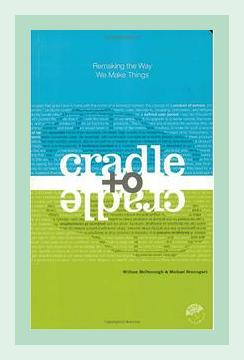Operations and Supply Chain ManagementLogistics
Title: Cradle to Cradle: Remaking the Way We Make Things
Authors: William McDonough, Michael Braungart
Publication Year: 2002
Introduction: Revolutionizing Design and Production
“Cradle to Cradle” by William McDonough and Michael Braungart is a visionary book that challenges the traditional “cradle-to-grave” model of industrial production and urges for an innovative “cradle-to-cradle” approach. This model aspires to create systems that reuse materials in continuous cycles, emulating nature’s regenerative processes. By exploring design, industrial practices, and logistics, the authors present a persuasive argument for rethinking the way products are conceived, manufactured, and recycled.
1. Understanding “Cradle-to-Grave” vs. “Cradle-to-Cradle”**
- Cradle-to-Grave:
- Traditional industrial systems operate on a linear model where products are made, used, and eventually discarded, creating waste.
-
Example: A plastic bottle is manufactured, used once, then thrown into a landfill where it remains for centuries.
-
Cradle-to-Cradle:
- Promotes a circular model where products are designed with their next life in mind, either returning safely to the environment or back into the production cycle.
- Example: A biodegradable bottle that decomposes into non-toxic components or can be upcycled into new products.
- Action: Advocating for or choosing products that are designed for either biological or technical nutrient cycles.
2. Biological and Technical Nutrient Cycles**
- Biological Nutrients:
- Materials designed to re-enter the environment safely, biodegrading without harming ecosystems.
- Example: Compostable packaging made from plant-based materials.
-
Action: Support brands and products that use biodegradable and compostable materials.
-
Technical Nutrients:
- Non-toxic, synthetic materials meant to be reclaimed and reused indefinitely without losing quality.
- Example: Durable, recyclable steel that can be repeatedly melted down to produce new steel products.
- Action: Invest in durable goods that are designed for disassembly and recycling.
3. Eco-Effectiveness vs. Efficiency**
- Efficiency: Doing more with less—minimizing waste and resource use—is the prevailing approach, but it often leads to minimal environmental benefits and can even sustain harmful practices.
- Example: Efficiently burning less fuel in a car still contributes to pollution.
-
Action: Rethink and redesign products to eliminate harmful impacts rather than minimizing them.
-
Eco-Effectiveness: Redefines our goals to create systems that inherently benefit the environment and human health.
- Example: A building designed with solar panels and green roofs to produce more energy than it consumes.
- Action: Support and implement eco-effective designs in homes, workplaces, and communities.
4. Redesigning Production Processes**
- Using Safe Materials:
- Avoiding harmful substances in the design of products and opting for non-toxic alternatives.
- Example: The design of a chair using materials free from hazardous chemicals, ensuring safety for users and the environment at the end of its life.
-
Action: Choose products and brands that disclose and commit to using safe, non-toxic materials.
-
Upcycling:
- Converting waste materials into new, higher quality products.
- Example: Nike’s use of scrap material from manufacturing to create new footwear.
- Action: Support businesses with upcycling initiatives and participate in recycling programs.
5. Localized Production and Logistics**
- Decentralized Manufacturing:
- Producing goods closer to where they are consumed to minimize transportation and its environmental impact.
- Example: Local farms providing produce to nearby markets, reducing the need for long-distance shipping.
-
Action: Buy locally-produced goods to support local businesses and reduce carbon footprints.
-
Efficient Logistics Systems:
- Designing supply chains that optimize resource use and reduce emissions.
- Example: Companies adopting rail and sea transport over air to reduce carbon emissions.
- Action: Encourage and support businesses that prioritize environmentally-friendly logistics solutions.
6. The Role of Renewable Energy**
- Harnessing Renewable Sources:
- Shifting reliance from fossil fuels to renewable energy sources.
- Example: A factory powered by solar, wind, or geothermal energy reducing its carbon footprint.
- Action: Advocate for or install renewable energy systems in homes and businesses.
7. Water Stewardship**
- Reducing Water Use and Pollution:
- Designing systems to purify and reuse water effectively, ensuring clean water supply.
- Example: Implementing water recycling systems in industrial processes to reduce freshwater use.
- Action: Use water-saving technologies and support initiatives that protect and clean water sources.
8. Personal Actions for a Cradle-to-Cradle Lifestyle**
- Choosing Sustainable Products:
- Example: Purchasing biodegradable cleaning supplies, clothing made from organic materials, and furniture designed for disassembly.
-
Action: Make informed purchases and support companies with transparent, sustainable practices.
-
Engaging in Recycling and Composting:
- Example: Home composting of organic waste, participating in community recycling programs.
-
Action: Establish a household system for composting biodegradable waste and recycle rigorously.
-
Advocating for Policy Change:
- Example: Supporting legislation that requires companies to design products that are either biodegradable or fully recyclable.
- Action: Engage with and support environmental advocacy groups that influence policy.
Conclusion: A Vision for Sustainable Design
“Cradle to Cradle: Remaking the Way We Make Things” presents a radical yet practical vision of sustainable design and production. By shifting from a linear to a circular model and promoting the use of safe, sustainable materials, individuals and businesses can create products and systems that are beneficial to both humanity and the environment. Practical steps, such as supporting local production, investing in renewable energy, and advocating for systemic change, allow everyone to contribute to this visionary approach to sustainability.
